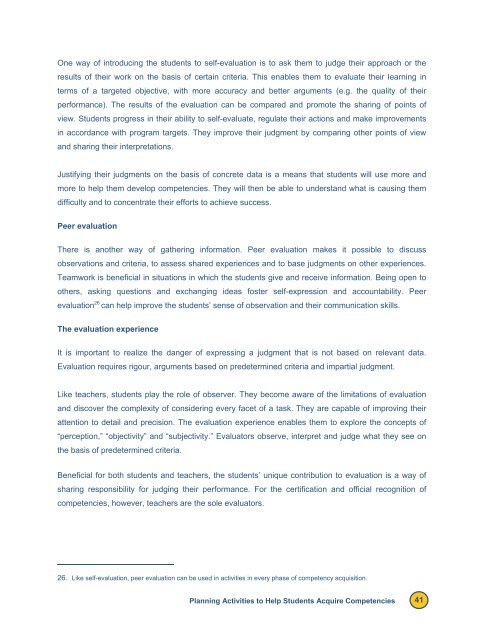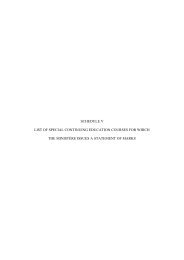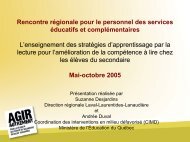Reference Framework for Planning Learning and Evaluation Activities
Reference Framework for Planning Learning and Evaluation Activities
Reference Framework for Planning Learning and Evaluation Activities
Create successful ePaper yourself
Turn your PDF publications into a flip-book with our unique Google optimized e-Paper software.
One way of introducing the students to self-evaluation is to ask them to judge their approach or the<br />
results of their work on the basis of certain criteria. This enables them to evaluate their learning in<br />
terms of a targeted objective, with more accuracy <strong>and</strong> better arguments (e.g. the quality of their<br />
per<strong>for</strong>mance). The results of the evaluation can be compared <strong>and</strong> promote the sharing of points of<br />
view. Students progress in their ability to self-evaluate, regulate their actions <strong>and</strong> make improvements<br />
in accordance with program targets. They improve their judgment by comparing other points of view<br />
<strong>and</strong> sharing their interpretations.<br />
Justifying their judgments on the basis of concrete data is a means that students will use more <strong>and</strong><br />
more to help them develop competencies. They will then be able to underst<strong>and</strong> what is causing them<br />
difficulty <strong>and</strong> to concentrate their ef<strong>for</strong>ts to achieve success.<br />
Peer evaluation<br />
There is another way of gathering in<strong>for</strong>mation. Peer evaluation makes it possible to discuss<br />
observations <strong>and</strong> criteria, to assess shared experiences <strong>and</strong> to base judgments on other experiences.<br />
Teamwork is beneficial in situations in which the students give <strong>and</strong> receive in<strong>for</strong>mation. Being open to<br />
others, asking questions <strong>and</strong> exchanging ideas foster self-expression <strong>and</strong> accountability. Peer<br />
evaluation 26 can help improve the students’ sense of observation <strong>and</strong> their communication skills.<br />
The evaluation experience<br />
It is important to realize the danger of expressing a judgment that is not based on relevant data.<br />
<strong>Evaluation</strong> requires rigour, arguments based on predetermined criteria <strong>and</strong> impartial judgment.<br />
Like teachers, students play the role of observer. They become aware of the limitations of evaluation<br />
<strong>and</strong> discover the complexity of considering every facet of a task. They are capable of improving their<br />
attention to detail <strong>and</strong> precision. The evaluation experience enables them to explore the concepts of<br />
“perception,” “objectivity” <strong>and</strong> “subjectivity.” Evaluators observe, interpret <strong>and</strong> judge what they see on<br />
the basis of predetermined criteria.<br />
Beneficial <strong>for</strong> both students <strong>and</strong> teachers, the students’ unique contribution to evaluation is a way of<br />
sharing responsibility <strong>for</strong> judging their per<strong>for</strong>mance. For the certification <strong>and</strong> official recognition of<br />
competencies, however, teachers are the sole evaluators.<br />
26. Like self-evaluation, peer evaluation can be used in activities in every phase of competency acquisition.<br />
<strong>Planning</strong> <strong>Activities</strong> to Help Students Acquire Competencies 41




